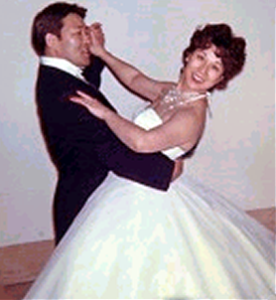The Masters of Grace, Poise

After 60 years of teaching aikido and etiquette in Old Town, Ken and Miye Ota are in a class all by themselves
Kenji Ota estimates he’s taught over a million students how to ballroom dance over the last 40 years as a teacher at UCSB. And that’s not including the students he’s taught for decades at his ballroom dancing school, the Cultural School, in Old Town.
The Cultural School, which teaches Aikido, Judo, ballroom dancing and etiquette, is owned and run by Kenji (who goes by Ken) and his wife, Miye Ota.
Even at 85, Ken is still teaching at UCSB, and a new generation of students is learning to brave social situations.
At Robertson Gym on weekdays, he’s usually in front of dozens of students, showing them the rhumba or the foxtrot. He yells to a group of girls hiding in the far corner of the gym and tells them to find a dance partner, admonishing them to be confident, telling them these are “life skills.”
He’s an intimidating force sometimes, but it’s easy to see they adore him and all say they enjoy his classes.
Back at the Cultural School, Aikido and ballroom dancing may seem an odd combination but after closer examination, they’re a lot more similar than they appear.
“Aikido is a martial art with class,” Miye says. And after looking at old pictures of Miye and Ken dancing in exhibitions, they’ve got class to spare.
The self-control of Aikido and the manners and protocol of ballroom dancing are interlinked in the studio classes for children and teens.
“It’s more powerful to be soft,” she said. “Here, they learn how to be friendly without being aggressive.”
At the etiquette class, Miye teaches things like a proper handshake, introductions and table manners, essential things that many children miss out on learning. If an etiquette class seems like a dated concept, Miye says that doesn’t stop people from coming far and wide for the classes.
“Even now we’re in demand,” she says. “Wherever our kids go they have poise.”
One of the top-ranked amateur ballroom dancers in the country, Porfirio Landeros, trained at the school. Landeros began taking aikido at the school as a 13-year-old and eventually started dancing as well. He was one of the hundred or so guests who came to Miye’s 90th birthday party recently.
Despite of their age, the pair show no signs of slowing down and have no trouble recounting their story.
They met at a World War II internment camp at Gila River in Arizona, where they lived for two years. After enduring the hardship there, they relocated to Philadelphia, where Ken found a factory job and Miye opened her own hair salon. They decided to move back to California and settled in Goleta.
The building that holds the Cultural School and the couple’s apartment was built by Ken and Miye’s brothers in 1948, and they’ve been there ever since.
Miye’s personal motto can be summed up simply: “The mind is stronger than the body.” It’s one of her secrets of a long life. Choosing to stay positive instead of dwelling on hardship makes for a longer, happier life, she says.
And the Otas have seen their share of hardship. During their stay at the internment camp, Miye’s father died and three of her brothers left to fight for the Allies. After Gila River, they dealt with the racism of a post-war United States. More recently, Ken has had his share of health issues and heart surgery.
“We don’t dwell on the bad things,” she says, lowering her voice, summing up the mission of the school as well as the Ota’s personal mantra. Their ability to transcend circumstances with grace, poise and manners is what has kept decades of students flocking back to the classes.
Miye says that each of her students has a different story to tell. Kids who were on the brink of suicide. Undisciplined children looking for family. Miye says they’ve seen it all.
Her remedy?
These days, she says, people don’t have fun.
